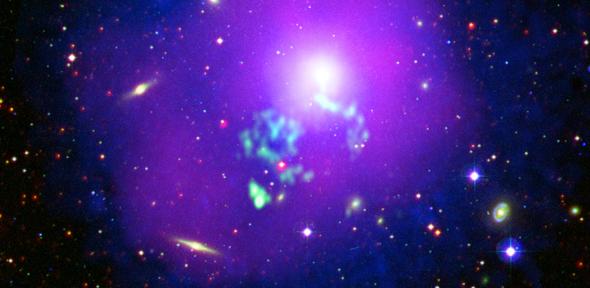
At its meeting in Paris today, the European Space Agency (ESA) selected the "The Hot and Energetic Universe" as the science theme for L2– the second Large-class mission in ESA’s Cosmic Vision science programme – expected to be launched in 2028, with the power to address some of the most fundamental questions in modern astrophysics.
This mission will address two key questions. How and why does ordinary matter assemble into the galaxies and galactic clusters that we see today, and how do black holes grow and influence their surroundings?
The theme was proposed by an international team, with major input from Professor Andy Fabian from Cambridge’s Institute of Astronomy. The same team is now well placed to lead the delivery of a major space observatory, with observing capabilities ideally matched to the L2 theme.
Hot gas in the Universe is the dominant form of ordinary matter, the same material that everything we see around us is made from. The hot gas forms the largest structures in the visible Universe, aggregated around clusters of galaxies. With temperatures of more than a million degrees, the gas emits copiously at X-ray wavelengths.
With the new mission, astronomers will measure the properties of galaxy clusters in the distant Universe, and map the physical characteristics of the largest structures known - information dramatically advancing our understanding of how these structures first assembled when the Universe was just two billion years old.
With the powerful new X-ray Observatory, astronomers will be able to look still further back, to observe the first supermassive black holes, and to a time when the first galaxies were forming, less than one billion years after the Big Bang. Because of the extremely high temperatures and the huge energies deposited by matter as it falls into a black hole, X-ray emission is the most reliable and complete way of revealing such accreting monsters.
Andy Fabian noted that “processes originating close to the black hole are able to influence galaxies and galaxy clusters on scales up to a billion times larger– this `cosmic feedback’ is therefore an essential ingredient of galaxy evolution models.”
The next step will be a call for an X-ray Observatory concept able to achieve the science goals. Once a mission concept has been selected there is expected to be a period of 3-4 years to consolidate the technology development. It will take another 10 years or so to build the Observatory.
In 2028, this mission should begin to reveal the “Hot and Energetic Universe” in unprecedented detail, and provide an answer to that most basic question - why does the Universe look like it does today?
Adapted from an ESA press release
European Space Agency announces broad plan for major space science missions over the next two decades, with Cambridge’s Institute of Astronomy involved at the highest levels.
This work is licensed under a Creative Commons Licence. If you use this content on your site please link back to this page.
